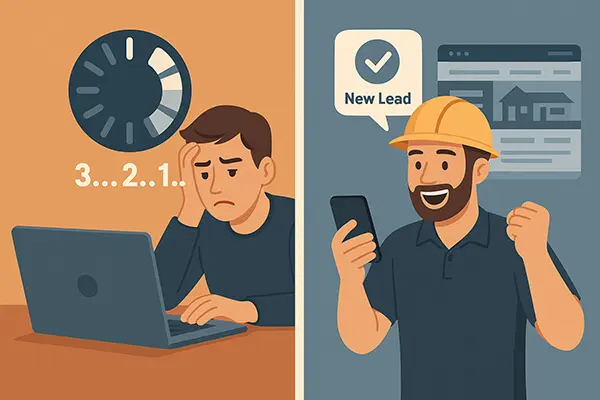
Is your website driving customers away before they even see what you offer?
If your pages take too long to load, you're not just frustrating visitors—you’re losing them. In today’s fast-paced digital world, every second counts. And for contractors and home service businesses, a slow website could mean the difference between landing a new job or missing out completely.
This post breaks down why website speed optimization matters and gives you actionable steps to make your site faster today. If you'd rather skip the hassle and have a professional handle it, our website optimization services are always here to help.
Why Website Speed Optimization Matters
First Impressions Are Everything
Your website is often the first interaction a potential customer has with your business. If it loads slowly, it sends the wrong message. Studies show that 53% of mobile visitors leave a site if it takes more than three seconds to load. That’s over half of your audience gone before they even see your services.
Speed Affects Your Bottom Line
Speed isn’t just a tech issue—it’s a sales issue. A delay of just one second can reduce conversions by 7%. That might not sound like much, but over hundreds of site visits, that’s a lot of missed opportunities.
Google Cares About Speed
Google uses page speed as a ranking factor. Its Core Web Vitals measure how fast your site loads, responds, and becomes usable. A slow website won’t just annoy users—it’ll hurt your visibility in search results.
Common Reasons Your Website Is Slow
Oversized Images
High-resolution images are great for showcasing your work, but if they're not compressed, they can drag your site down. Many contractor sites are filled with large photo galleries that load slowly.
Cheap Hosting
If you're using a bargain-basement host, you’ll likely get bargain-basement speed. Shared hosting might save a few dollars, but it slows down your entire site when traffic increases.
Too Many Plugins or Scripts
Every plugin or third-party script adds weight. If you’re running a WordPress site, keep it lean. Only use plugins that are essential to your business.
No Caching
Without caching, your site rebuilds each page from scratch every time someone visits. That wastes server resources and time.
Bloated Themes
Many pre-built themes come with extra code and styling options you’ll never use. The more bloated your theme, the slower your site.
How to Test Your Website Speed
You don’t have to guess—tools can show you exactly what’s slowing your site down.
Tools You Can Use
-
Google PageSpeed Insights: Provides Core Web Vitals and suggestions
-
GTmetrix: Offers detailed waterfall charts and performance grades
-
Pingdom: Easy-to-understand speed results and history tracking
Key Metrics to Watch
-
Time to First Byte (TTFB)
-
Largest Contentful Paint (LCP)
-
Cumulative Layout Shift (CLS)
-
Total Page Size
-
Number of Requests
Actionable Ways to Speed Up Your Website
1. Compress and Resize Images
Before uploading any images, reduce their size. Use tools like ShortPixel or TinyPNG. Aim for under 150KB whenever possible.
2. Use a Content Delivery Network (CDN)
A CDN stores copies of your website on servers around the world. Visitors get your content from the nearest server, speeding up load times.
3. Enable Browser Caching
This stores files in the user’s browser so they don’t have to download everything again on their next visit. It’s a simple but powerful boost.
4. Minify Your Code
Remove extra spaces and comments in your site’s code. Minifying HTML, CSS, and JavaScript can reduce load time without changing functionality.
5. Upgrade Your Hosting
Switch to a reputable, performance-based host. Look for ones that offer built-in caching and fast support response times.
6. Limit External Scripts
Tools like chatbots, analytics, and ad networks can slow things down. Keep only what’s necessary and load scripts asynchronously when possible.
7. Lazy Load Images and Videos
With lazy loading, images only load as the user scrolls. This makes the initial page load much faster and improves performance scores.
8. Choose a Lightweight Theme
If you’re on WordPress, avoid feature-heavy themes. Look for speed-optimized themes like Astra or GeneratePress.
How Speed Ties into SEO
Core Web Vitals Matter
Google’s algorithm favors websites that meet Core Web Vitals benchmarks. That means better rankings and more organic traffic for fast-loading pages.
Better Mobile Experience
More than half of all website traffic comes from mobile devices. A slow mobile experience is a surefire way to get left behind.
Improved Crawlability
Faster websites allow search engines to crawl more pages. That helps with indexing and can improve the reach of your site in search results.
More Trust, More Clicks
Fast sites feel more professional and reliable. Visitors are more likely to click, browse, and contact you when things work smoothly.
Tools to Keep Your Website Fast
-
WP Rocket (caching and performance for WordPress)
-
NitroPack (all-in-one performance platform)
-
ShortPixel (image compression)
-
Cloudflare (CDN and security)
-
SiteGround or Kinsta (fast hosting providers)
Run speed tests regularly and stay on top of updates. Your website isn’t set-it-and-forget-it—it’s a living tool for your business.
Final Thoughts
If your site feels sluggish, your customers probably think so too. Website speed optimization isn’t just a technical checklist—it’s about delivering a better experience for your users and improving your bottom line.
Take the first step today. Test your website. Apply the fixes you can. And if you’d rather have a pro handle the heavy lifting, we’ve got you covered with expert web design and optimization services tailored for contractors and home service pros.
Ready to give your site the boost it deserves? Contact us today for a free website speed audit.

